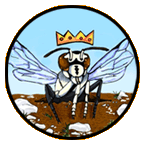
Wasps may not be as big as lions or bears, but these insects are among the most successful predators on Earth! Different wasps species have different ways of preying on other animals. Some wasps, called parasitoids, lay their eggs in the bodies of live insects (hosts). As the larva grows, it feeds on the host from the inside out! But humans have little to fear. Wasps are uninterested in people unless their nests are threatened. In fact, wasps prey on many of the insect pests that destroy crops, so they are ultimately beneficial to humans.
With more than 100,000 species, there's a lot to learn about wasps. They fall into two main categories:
- Social wasps build nests and live in colonies of up to thousands of individuals. Hornets and yellowjackets are social wasps.
- Solitary wasps don't live in large nests with other wasps, but live alone. Some build small nests in the ground or in natural crevices. Others get their nests from other insects. Parasitoid wasps lay their eggs in the bodies of "host" insects, while cleptoparasitic wasps steal their nests to use as their own.





 Biodiversity
Biodiversity
 Brain
Brain
 Genetics
Genetics
 Marine BiOLogy
Marine BiOLogy
 MicrobiOLogy
MicrobiOLogy
 PaleontOLogy
PaleontOLogy
 ZoOLogy
ZoOLogy
 AnthropOLogy
AnthropOLogy
 ArchaeOLogy
ArchaeOLogy
 Astronomy
Astronomy
 Climate Change
Climate Change
 Earth
Earth
 Physics
Physics
 Water
Water




